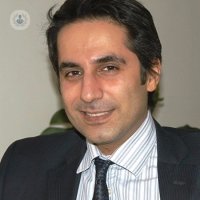The LINX procedure: cutting-edge treatment for GORD
Written by:The LINX reflux management system is a revolutionary device designed to help patients in the treatment of gastro-oesophageal reflux disease, otherwise known as GORD. Mr Majid Hashemi is a high-level bariatric & gastrointestinal surgeon, with extensive experience in the surgical treatment of acid reflux. Here he explains what the LINX reflux management device is, and how it can help change patients’ experiences of GORD for the better.

What is the LINX reflux management system?
The LINX system or LINX device is a small, flexible band of titanium beads, linked together in the form of a bracelet. The beads have a magnetic core, meaning they attract and help the sphincter to remain closed.
How does the LINX device work?
In those with GORD, the lower oesophageal sphincter is generally weak, meaning acid and bile can come up from the stomach and enter the oesophagus.
The LINX device is designed to restore the reflux barrier, while allowing food and liquid to still enter the stomach. The force of swallowing is strong enough to break the magnetic bond, meaning the patient can still eat and drink as normal. The magnetic attraction closes the sphincter immediately afterwards, so reflux cannot occur.
How is the LINX device placed?
The LINX management system is placed using minimally invasive (sometimes called laparoscopic) surgery, which usually takes just under an hour (around 45 minutes). This means the patient can usually go home the same day or the next, and scarring is less than in traditional surgical procedures.
Who performs the procedure to place the LINX device?
The LINX reflux management system is a relatively new development in the treatment of GORD and acid reflux. This means there are only a handful of surgeons in the UK who are currently able to perform this procedure.
What should patients expect after the LINX device is placed?
As the LINX management system is put in place using minimally invasive surgery, patients will generally be seen as a day case, with no overnight stay necessary. The incredible advantage of the LINX device is that it allows patients to eat a normal diet after surgery. The traditionally performed procedure for GORD, the Nissen fundoplication, does not allow this and patients are restricted in their diet, starting on a liquid diet that builds up to solids over time.
Recovery is simple and straightforward, with very little discomfort, and minimal scarring.
Another advantage of the LINX device is that it is removable, making the procedure completely reversible if necessary. Removal of the device returns the oesophagus to exactly the same state it was in before implantation. As the device is a new development in the treatment of reflux management, its effects have not been studied long-term, and it is possible that the device may need to be replaced after the initial procedure, later down the line.
The procedure is shown to be safe from studies performed, and widely successful, with over 90% of patients reporting that they could reduce their medication after the procedure, and 70% reporting that they were able to completely give up their medication.
If you would like to learn more about the LINX management system, make an appointment with a specialist to discuss your options.


